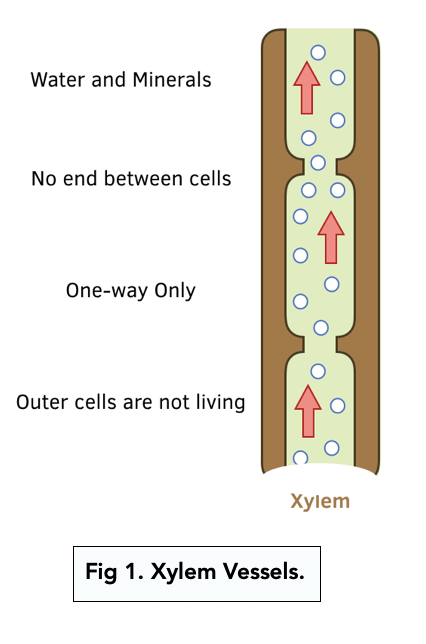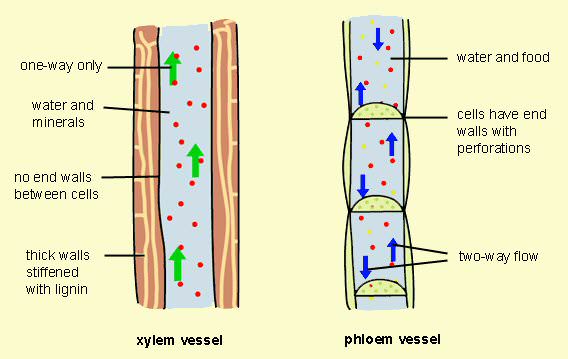Table of Contents
Differences Between Transport of material in Xylem and Phloem
Plants have developed complex systems to transport essential materials throughout their bodies. Two key transport tissues in plants are the- Xylem and Phloem.
The Xylem primarily transports water and minerals from the roots to the leaves, while the Phloem primarily transports sugars, amino acids and other organic compounds both upwards and downwards within the plant. Understanding the differences between these two transport systems is important to understanding how plants grow and thrive. In this article, we will explore the key differences between the transport of materials in xylem and phloem on the basis of their structure, mechanism of transport, energy requirements, regulation and carriers.
7 Important Diffrences between Transport of material in Xylem and Phloem in Tabular format –
| Factors | Xylem | Phloem |
|---|---|---|
| Material Transported | Xylem transports water andminerals in plants. | Phloem transports theproducts of photosynthesis,amino acids and otherorganic substances in plants. |
| Direction of Transport | The movement of water isunidirectional in xylem. Its fromRoots to leaves | The movement ofsubstances can bemultidirectional.Both upwards and downwards |
| Mechanism of Transport | Major operating forces arediffusion and transpirational pull. | Translocation (active transport) |
| Structure of Transport Tissues | Dead cells: tracheids and vessel elements | Living cells: sieve tube members and companion cells |
| Energy Requirement | Passive process, no energy required | Active transport requiring ATP |
| Regulation of Transport | It is not influenced bymetabolic inhibitors. Water potential gradient influenced by soil water availability, atmospheric humidity and temperature | Regulated by concentration of sugars and hormones. Phloem transport is inhibited by metabolic inhibitors. |
| Carriers | Xylem vessels and tracheids | Sieve tubes with adjacent companion cells |
 |  |
Differences Between Transport of material in Xylem and Phloem – Explained in Details
Differences Between Transport of material in Xylem and Phloem -Types of Material Transported –
The Xylem primarily transports water and dissolved minerals from the roots to the leaves. The water is absorbed from the soil through root hairs and moves into the Xylem vessels and tracheids, which are long, tube-like structures made of dead cells. These cells form a continuous network that extends throughout the plant, allowing water and minerals to be transported to all parts of the plant. In contrast, the Phloem primarily transports sugars, amino acids and other organic compounds from source to sink. The source is the site of production or storage of these substances, while the sink is the site of utilisation or storage.
Differences Between Transport of material in Xylem and Phloem – Direction of Transport
The direction of transport in the Xylem is unidirectional, moving from the roots to the leaves. This is because the Xylem primarily transports water and minerals that are needed for photosynthesis and other metabolic processes in the leaves. The direction of transport in the Phloem, on the other hand, can be bidirectional or multidirectional. This is because the Phloem transports substances that are needed in different parts of the plant, such as sugars produced in the leaves that are needed for growth and development in other parts of the plant.
Differences Between Transport of material in Xylem and Phloem – Mechanism of Transport
Transport in the Xylem occurs primarily through a combination of diffusion and Transpirational pull. Diffusion is the passive movement of substances from an area of high concentration to an area of low concentration, while Transpirational pull is the force that drives water and dissolved minerals up the Xylem. Transpiration occurs when water evaporates from the leaves through tiny pores called stomata. This creates a negative pressure gradient that pulls water and minerals from the roots to the leaves.
In contrast, transport in the Phloem occurs through a process called Translocation, which involves the active movement of materials from source to sink. This process requires energy in the form of ATP. The movement of materials in the Phloem is facilitated by specialized cells called sieve tube members and companion cells. The sieve tube members are long, thin cells that form a continuous network throughout the plant. The companion cells are located adjacent to the sieve tube members and provide them with energy and other nutrients needed for Translocation.
Differences Between Transport of material in Xylem and Phloem – Structure of Transport Tissues
The Xylem and Phloem are two types of specialised plant tissues responsible for transporting water, nutrients and other essential substances throughout the plant body. The Xylem consists of dead cells called tracheids and vessel elements that are arranged end-to-end to form long tubes. These tubes provide a continuous pathway for water and dissolved minerals. The walls of Xylem cells are thickened with lignin, which provides structural support and helps to prevent collapse of the Xylem under the negative pressure generated during Transpiration. In contrast, the Phloem consists of living cells called sieve tube members and companion cells that are arranged end-to-end to form long tubes. Sieve tube members have perforated end walls called sieve plates that allow for the transport of materials between cells. Companion cells are specialised cells that help to maintain the metabolic activity of the sieve tube members.
Differences Between Transport of material in Xylem and Phloem – Energy Requirement
Transport in the Xylem does not require energy, as it is a passive process driven by Transpiration. In contrast, transport in the Phloem requires energy in the form of ATP, as it involves the active transport of materials from source to sink. The energy for Phloem transport is provided by companion cells, which are connected to sieve tube members through plasmodesmata, small channels that allow for the exchange of materials between cells.
Differences Between Transport of material in Xylem and Phloem- Regulation of Transport
The transport of materials in the Xylem is regulated by the water potential gradient, which is influenced by factors such as soil water availability, atmospheric humidity and temperature. The transport of materials in the Xylem is not influenced by metabolic inhibitors. In contrast, the transport of materials in the Phloem is regulated by a number of factors, including the concentration of sugars and hormones. The transport of materials in the Phloem is inhibited by metabolic inhibitors, which can disrupt the activity of the ATP-powered pumps responsible for loading and unloading materials in the sieve tube members.
Differences Between Transport of material in Xylem and Phloem- Carriers
In the xylem transport is carried out by specialised cells called tracheids and vessel elements that are arranged end-to-end to form long tubes. These cells are dead and have no cytoplasm or cell contents at maturity, but they are highly specialised for water transport. Transport in the phloem is carried out by a specialised type of living cells called sieve tube members. These cells are connected end-to-end by sieve plates, which are perforated end walls that allow for the transport of materials between cells. Adjacent companion cells, which are specialised parenchyma cells are also involved in the transport process by providing energy and support to the sieve tube members.
Also Check – Functions of the Xylem and Phloem
Also Check – How are Water and Minerals Transported in Plants?
Also Check – What are the Components of Transport System in Highly Organised Plants
Also Check – What is Transpiration Stream
Also Check –Transportation in Plants for Class 10th


7 Comments on “What are the Differences between the Transport of Materials in Xylem and Phloem?”